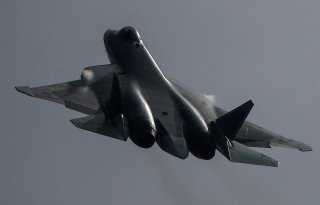Is Russia's Su-57 Stealth Fighter Project Dead in the Water?
Only time will tell if Russia’s defense industry is able to meet Moscow's ambitious mass production schedule, especially now that the Su-57 may find itself competing for funding and resources with the newly-released Checkmate fighter.
Widely regarded as the pinnacle of Russian fighter engineering, the Sukhoi Su-57 (NATO reporting name “Felon”) is among the most capable air superiority platforms in the world.
The fighter jet that would become Sukhoi’s Su-57 grew out of the PAK FA program to procure a fifth-generation stealth fighter. Intended as Russia’s answer to the F-22 Raptor, the plane entered testing in the 2010s under the internal T-50 designation. Though the state trials were formally completed by 2015, progress on the Su-57’s bespoke Izdeliye 30 engines lagged behind the rest of the plane. The Russian military had to scale down their procurement estimates and push back the fighter’s delivery timeline in response to chronic budget shortfalls, further exacerbated by the creeping economic impact of Western sanctions and India’s 2018 withdrawal from the Sukhoi/HAL Fifth Generation Fighter Aircraft FGFA program to develop a Su-57 derivative.
Moscow managed to breathe new life into the financially moribund Su-57 program in the summer of 2019. With direct intervention from the Putin administration, the Defense Ministry reportedly drove down the fighter’s flyaway cost by twenty percent to around $40 million per unit and ordered as many as seventy-six fighters at this new price. The first serially produced Su-57 entered service in December 2020, with the rest of the batch to be delivered by 2028.
Though loosely classified as a twin-engine multirole fighter, the Su-57 can more accurately be described as an air superiority platform with precision strike capabilities. The plane boasts a speed of up to Mach 2 without the use of afterburners, an operational range of 3,500 kilometers, 3D thrust vectoring for supermaneuverability in dogfighting scenarios, and twelve hardpoints equally split between internal and external slots. The fighter’s radar-absorbent construction materials and modern airframe design offer some degree of stealth performance, especially from the front, but the Su-57 does not prioritize low observability. It is less of a dedicated stealth fighter than it is an anti-stealth fighter, leveraging raw speed, maneuverability, and sophisticated targeting tools to threaten high-priority aerial targets like the F-35.
The fighter boasts a formidable and growing arsenal of air-to-air missiles, reportedly including the new R-37M long-range hypersonic missile with an operational range in excess of 300 km. Its primary medium-range armament will be the upcoming K-77M, a beyond-visual-range air-to-air missile (BVRAAM) with an active electronically scanned array radar seeker. For ground attack missions, the Su-57 can be outfitted with a wide array of precision-guided bombs from the KAB family, as well as Kh-35 and Kh-38 anti-ship and air-to-surface missiles. Earlier, unconfirmed reports alleged that the Su-57 could be fitted with a variant of the Kh-47M2 Kinzhal air-launched ballistic missile. The Su-57 will likewise support Sukhoi’s S-70 Okhotnik-B heavy combat drone. As a loyal wingman, Okhotnik-B will be able to perform reconnaissance, surveillance, and strike missions in tandem with the Su-57 to which it is attached, whilst also providing targeting information to help cue the fighter’s long-range weapons.
With the Su-57, Sukhoi largely succeeded in creating an exceptional air dominance platform with the ability to hold NATO’s latest stealth fighters at risk. But, in 2021 just as in 2011, the single greatest threat to the Su-57 lies not on the battlefield but in the ledger books. Only time will tell if Russia’s defense industry is able to meet Moscow's ambitious mass production schedule, especially now that the Su-57 may find itself competing for funding and resources with the newly-released Checkmate fighter. As the Felon slowly enters service in Russia’s military, it is becoming increasingly apparent that the long-term financial solvency of the Su-57 program hinges on the Kremlin’s ability to secure a steady flow of foreign funding for the fighter’s export version.
Mark Episkopos is a national security reporter for the National Interest.
Image: Reuters

